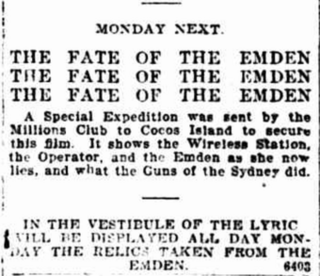
The Bank of New South Wales (BNSW), also known commonly as The Wales, was the first bank in Australia, being established in Sydney in 1817 and situated on Broadway. During the 19th century, the bank opened branches throughout Australia and New Zealand, expanding into Oceania in the 20th century. It merged with many other financial institutions, finally merging with the Commercial Bank of Australia in 1982 and being renamed to the Westpac Banking Corporation on 4 May that year under the Bank of New South Wales Act 1982.

How We Fought the Emden is a 1915 Australian silent documentary film from cinematographer Charles Cusden about the Battle of Cocos during World War I, where the Australian ship Sydney sunk the Emden.
Sentenced for Life is an Australian film directed by E. I. Cole. It was an adaptation of a play performed by Cole and his Bohemian Dramatic Company as early as 1904.
Montague Scott (1835-1909), also known as "Montagu Scott", was a London born artist, photographer and cartoonist. He emigrated to Australia 1855 and was the official photographer for the Duke of Edinburgh's visit in 1868. He was cartoonist for the Sydney Punch from 1866 to 1886.
The Kelly Gang; or the Career of the Outlaw, Ned Kelly, the Iron-clad Bushranger of Australia is an 1899 Australian play about bushranger Ned Kelly. It is attributed to Arnold Denham but it is likely a number of other writers worked on it.
Edward Charles Cracknell was an electrical engineer, Superintendent of Electric Telegraphs, New South Wales, and Lieutenant-Colonel commanding the Submarine Miners of the New South Wales Militia. He is considered Australia's third telegraph pioneer, after S. W. McGowan of Victoria and Charles Todd in South Australia.

Mates from the Murrumbidgee is a 1911 Australian silent movie. It is considered a lost film and was arguably the first Australian war film, being set during the Boer War.
The Royal Lyceum was a small theatre in York Street, Sydney founded in 1854, which was redeveloped and renamed many times, finally as the Queen's Theatre, by which name it closed in 1882.
Frank Towers (1835–1886) was an English actor, playwright and stage producer.

William James Holloway, known professionally as W. J. Holloway, was an Australian actor and stage manager who after some successes moved to London, from where he made several tours of South Africa. He married twice; and recognising the talent of his second wife's daughter, developed it to the full and drove her, as Essie Jenyns, to fame and exhaustion. He also made competent actors of his own children; he was an excellent teacher.
Frederick Ward was an English-born actor and theatre manager in Australia. He founded Sydney's first repertory theatre.
William Dind was an hotelier and theatre manager in Sydney, Australia, where he was the longtime lessee of the Royal Victoria, and Prince of Wales theatres. He settled on Sydney's North Shore, where he was active in local government, and he and his son William Forster Dind, aka W. Forster Dind or William Dind jun, ran hotels which were popular with theatrical people.
Mary Gladstane was an Irish-American actress of the 19th-century who had a considerable career in Australia, along with her husband and manager, L. M. Bayless.
The Missing Partner, or the Swagman is a 1904 Australian play by Edward Irham Cole. The play was set in the world of mining.
Only a Fool, or Chico the Jester is a 1880 Australian play by F. R. C. Hopkins. It was produced by Alfred Dampier as a vehicle for Dampier and his daughters.
£SD, or One of the Crowd is a 1882 Australian play by F. R. C. Hopkins.
Outlaw Kelly is a 1899 Australian play about Ned Kelly by Lancelot Booth.
Hazard; or, Pearce Dyceton's Crime is a 1872 Australian stage play by Walter Cooper.
Colonial Experience is a 1868 Australian stage play by Walter Cooper. It was Cooper's first play and the only one known to have survived in script form.
To the West is a 1896 Australian stage play by Alfred Dampier and novelist Kenneth Mackay. It was Mackay's first play.




